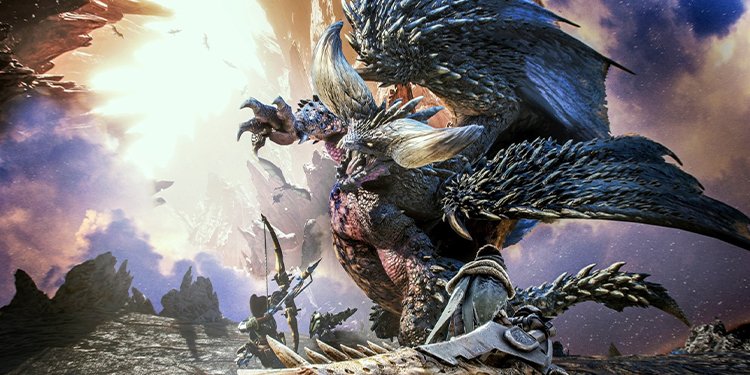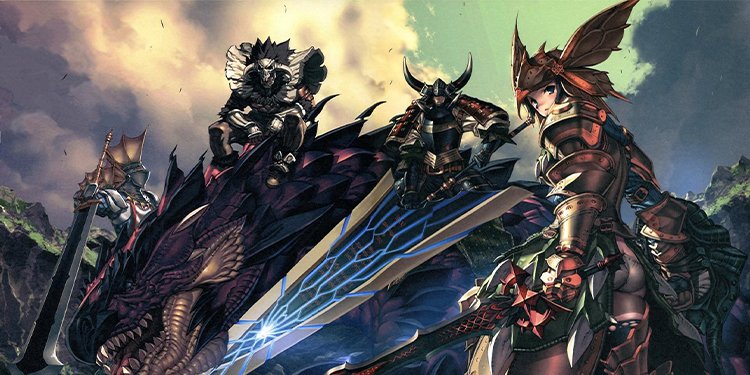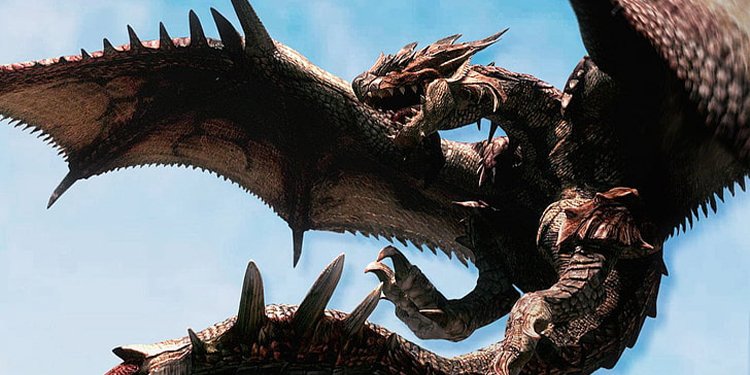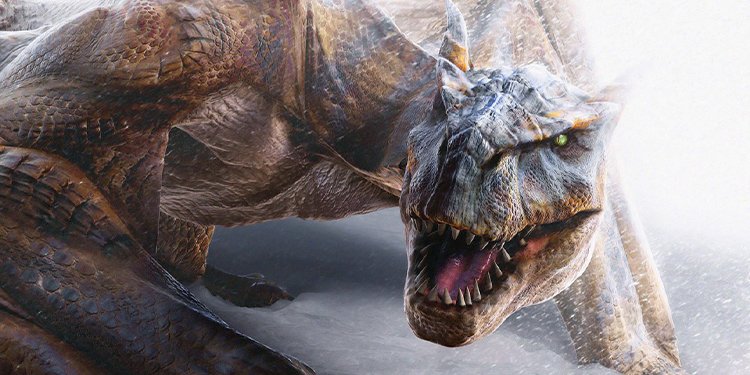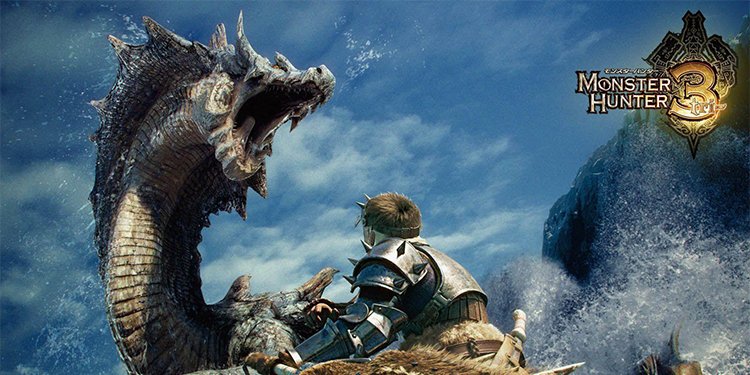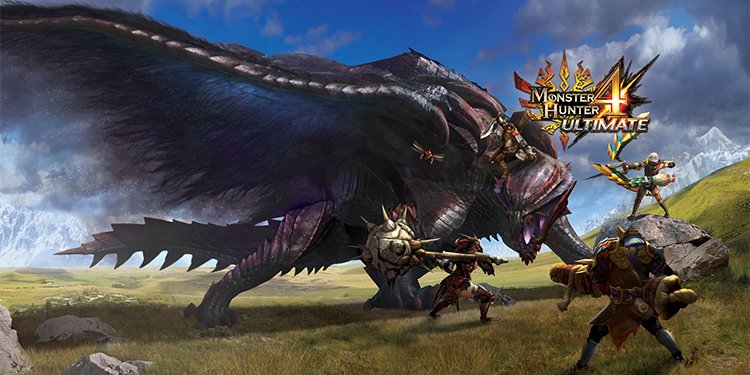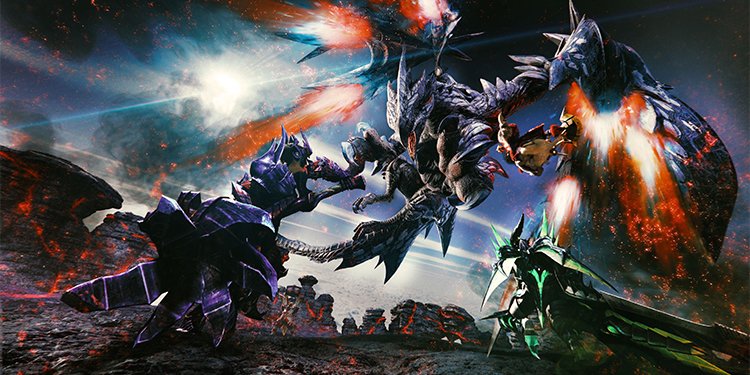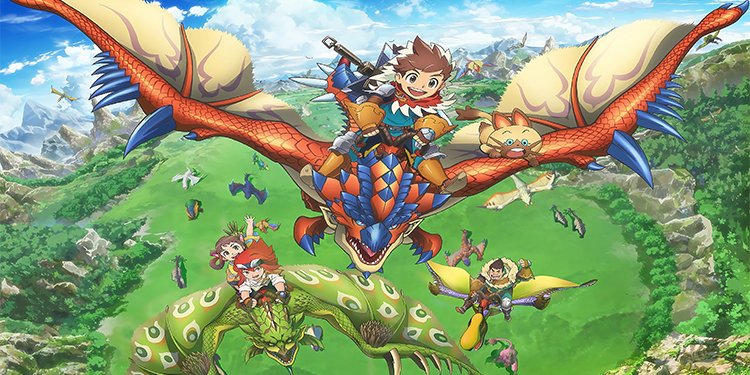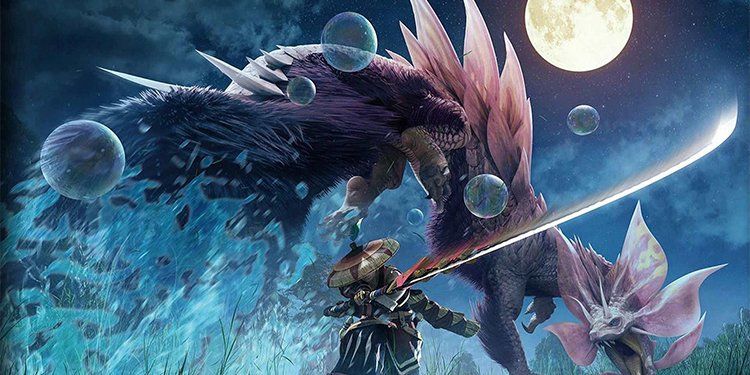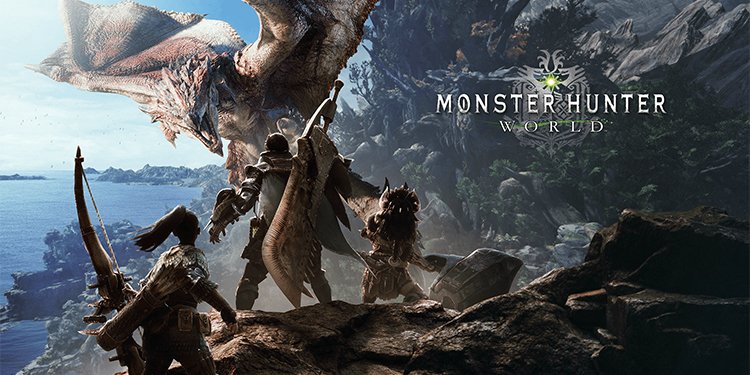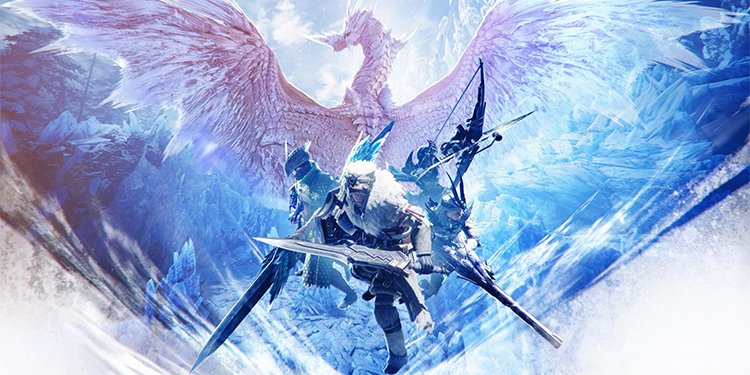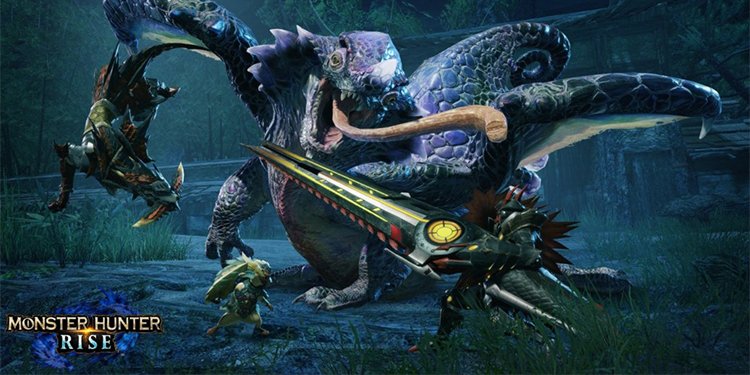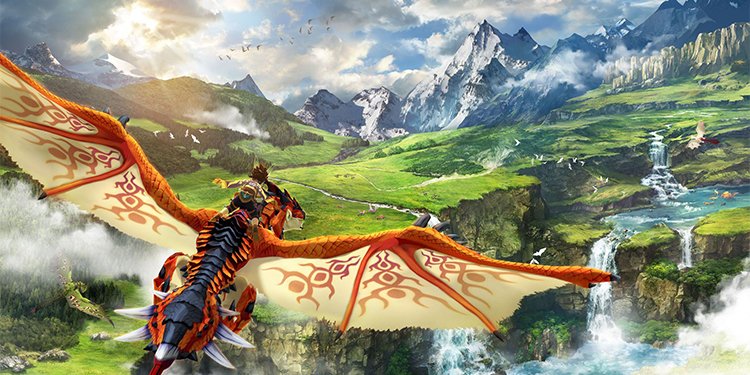Since the franchise unveiled its wings in 2004, Capcom has published six main Monster Hunter Games plus five significant international spin-offs. The series is tough to understand, though, as Japanese and international versions can be confusing. Moreover, there’re Japanese-only versions, as well as Japanese-only spin-offs. In summary, Monster Hunter games are divided by generations. Each generation has the original Japanese release, plus enhanced versions or ports for other consoles and countries. Some generations also include spin-off titles. Because we did not include the Japan-exclusive spin-offs (like the former Monster Hunter Online), we found: We could say the total is 16 Monster Hunter entries
Every Monster Hunter Games in Order
Monster Hunter is an action RPG title with a semi-open-world setting. The player takes the role of a hunter who must capture or kill giant monsters all over the map. These monsters drop powerful loot and resources. Moreover, most beasts have bounties that players can trade to buy weapons, armor, and trinkets. However, unlike other RPGs, the hunters have no attributes. Instead, character progression depends entirely on gear. That said, these games have about 14 weapon archetypes, most of which can apply elemental damages or status effects. Naturally, the stronger the enemy, the better the gear you need and loot. Such is the gameplay loop. You hunt monsters, grow stronger, and face stronger enemies. There’s, of course, a fluid, action gameplay that makes these titles come together. Hunters can attack, dodge, parry, perform combos, use abilities, tools, and drink potions. Lastly, there’s a main quest on every Monster Hunter as well. Once you go through the story, you can play it again with increased challenges. The newer titles in the series allow multiplayer co-op, with up to 4 people hunting together, further increasing the difficulty.
First Generation
Monster Hunter – 2004 (Main Series)
The first game in the Capcom series debuted in 2004 for PlayStation 2. It’s a Japan-exclusive release, but it reached international markets with the enhanced port. The title follows Kokoto, a hero looking to protect a village from giant flying creatures, Wyverns. Kokoto is a hunter trainee, and he must complete a series of challenges to rise within the hunter guild. Overall, the title presented the core characteristics of the series. It brought eight weapon archetypes (melee and ranged), plus the ability to gather resources from monsters.
Monster Hunter Freedom – 2005 (International Version / Enhanced Port)
The studio released an enhanced version in 2005, Monster Hunter Freedom. It debuted for the PlayStation Portable with improved visuals, extra content, and new monster kinds (subspecies).
Second Generation
Monster Hunter 2 – 2006 (Main Series)
The sequel debuted in 2006 for PlayStation 2 in Japan. The title brought about 24 new enemies, as well as returning monsters from the previous title. Overall, it was an improvement over the first title. However, as the first game, the series was not very popular outside of Japan. Monster Hunter 2 also allowed players to create their avatars through a character creation screen. As for Kotoko, there’s a Kotoko Village in the game you can visit at any time. The adventure takes players to several towns and villages where you need to protect the locals from powerful beasts. These villages are varied, offering a multitude of side quests and NPCs not present in the original game.
Monster Hunter Freedom 2 – 2007 (International Version / Enhanced Port)
In 2007, Capcom launched an enhanced version for PlayStation Portable and iOS in the USA and Europe, Monster Hunter Freedom 2. In 2008, Capcom launched an expansion for the PSP version, Monster Hunter Freedom Unite. It adds 50 hours of gameplay with new weapons, monsters, and areas. It also added a co-op multiplayer feature by allowing up to 4 players on a hunting party.
Third Generation
Monster Hunter 3 Tri – 2009 (Main Series)
Monster Hunter 3 Tri debuted in 2009 for Nintendo Wii. It was not a PlayStation 3 exclusive due to budget cuts. This is the Japanese version, but it debuted under the same name for the USA, Europe, and Australia in 2010. The third entry is similar to the games before. Players create an avatar and enter the world to complete missions for the Hunter Guild. In essence, it has three mission types: hunting, capture, and recollection. It also had an online mode where players could earn points by completing missions. Then, these points can increase Hunter’s rank to find better assignments. Also, the solo mode emphasized free-roaming, where players could explore a deserted island for resources, loot, and enemies.
Monster Hunter 3 Ultimate – 2011 (International Version / Enhanced Port)
In 2010, Capcom launched an enhanced version for the PlayStation 3 and the PlayStation Portable, Monster Hunter Portable 3rd. That’s a Japanese-only game, though. So, in 2011, there was another enhanced version for Nintendo 3DS and Wii U, Monster Hunter 3 Ultimate. It’s the international version.
Monster Hunter Dynamic Hunting – 2011 (Spin-off)
Dynamic Hunting was a spin-off arcade game for iOS and Android. It debuted in 2011 and featured both co-op and single-player modes. It’s not currently available in official stores.
Fourth Generation
Monster Hunter 4 – 2013 (Main Series)
Monster Hunter 4 debuted in 2013 for Nintendo 3DS (Japan). It’s the second game in the series for the 3DS, or the first in the main storyline going straight to the Nintendo handheld device. The fourth title had a stronger focus on platforming. As such, players could now climb walls fluidly in any direction. Also, hunters could grab onto monsters to attack them. Game environments also changed. The maps became larger and had plenty of vertical spaces like mountains and buildings. Also, the game included a Frenzy Virus system that increased the monster challenge.
Monster Hunter 4 Ultimate – 2015 (International Version / Enhanced Port)
Monster Hunter 4 Ultimate debuted for Nintendo 3DS in 2015 for North America and Europe.
Monster Hunter Generations – 2015 (Spin-off)
Monster Hunter Generations (Monster Hunter X in Japan) debuted in 2015 for Nintendo 3DS. However, it reached international markets in 2016. The spin-off title features similar gameplay as the games before. For novelties, it has special attacks and new combat styles. Moreover, it allows players to control Felines, a magical cat that often accompanies the protagonist. Lastly, Generations has the same 14 weapon archetypes of Monster Hunter 4, plus monsters and areas seen in previous titles.
Monster Hunter Stories – 2016 (Spin-off)
Marvelous Studio created Monster Hunter Stories. The game debuted under Capcom distribution in 2016 (Japan) and 2017 (internationally). It’s available for the Nintendo 3DS. Unlike its predecessors, the playable character is a Rider. A Rider is a person who can bond with monsters, so Riders can ride them, use them in battle, and become friends with the creatures. The protagonist can raise friendly monsters to battle against hostile monsters. He can also ride them, customize their abilities, and perform special attacks. The game revolves around stealing eggs from the monster’s nest. Moreover, instead of action gameplay, Stories presents turn-based combat with a Rock-Paper-Scissor design.
Monster Hunter Generations Ultimate – 2017 (Spin-off)
Monster Hunter Generations Ultimate is the latest version of the Generations spin-off. It debuted for Nintendo Switch in 2017 (Japan) and 2018 (worldwide). The port had some novelties compared to the base game. It introduced two boss-level monsters, various game modes, new weapon movements, new monster types, and more. It also added new mechanics like daily goals, higher weapon levels, in-game delivery services, and the Transfiguration system. The latter is about combining armor pieces to create an item that mixes stats and aesthetics. Generations Ultimate is known as Monster Hunter XX in Japan.
Fifth Generation
Monster Hunter World – 2018 (Main Series)
Monster Hunter: World launched worldwide for PlayStation 4, Xbox One, and Windows. The Capcom game debuted in 2018, and it sits as one of the best RPGs you can play right now. World represents a massive improvement in the series. Every area of previous games is better, refined, and more fluid. For example, areas are bigger, better looking, and with added detail. There’re also no loading screens between map areas, so traveling the world is fluid and fast. The setting is fully open-world, so the game has extreme freedom in how they want to play it. You can free-roam, collect resources, follow side missions, or follow the main quest. Lastly, the game has 14 weapon archetypes plus some new abilities. These include knocking down monsters, new mobility and offensive tools, and other gadgets.
Monster Hunter World: Iceborn – 2019
Iceborn is a DLC expansion for Monster Hunter: World. It introduced new monsters, new weapon moves, and new areas. There’s also a plot that revolves around a strange phenomenon. The story happens in Hoarfrost Reach Locale, a new area that continues the World plot. Iceborn is a massive DLC that includes tons of content, gear, loot, and new monsters. Additionally, it includes a new difficulty rank to deliver the most challenging monsters in the series. Lastly, the DLC also adds a new mobility tool, plus a new offensive tool.
Monster Hunter: Rise – 2021 (Main Series)
Rise debuted worldwide in 2021 for the Nintendo Switch. It’s quite similar to Monster Hunter World, albeit it’s a Nintendo exclusive. Rise introduces another avatar hunter to capture, defeat, or hurt a monster. These monsters reward bounties, loot, and resources. The game doesn’t offer many novelties. Instead, it has the same weapon types as World and most of the monsters present in the previous entry. Lastly, it has both local multiplayer and online multiplayer. It allows up to 4 players in the same party. Similarly, it has a game mode known as “Rampage,” where a party of players must defend a village from monster hordes.
Monster Hunter Stories 2: Wings of Ruin – 2021 (Spin-off)
Wings of Ruin is the second installment of the turn-based Monster Hunter spin-off. It debuted in 2021 for Nintendo Switch worldwide. Players take the role of Rider again. As before, Riders can befriend monsters to ride and use them in battle. The protagonist is a grandson of the legendary Rider Red. Soon enough, the story introduces Ena, a Wyverian girl guarding an egg. The protagonist and Red must protect the egg, but it could hatch and awaken a powerful monster.
All Hunter Monster Games in Chronological Order
